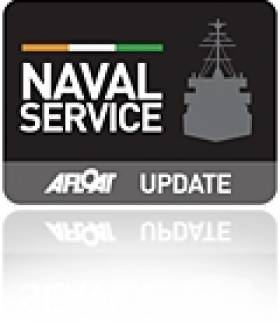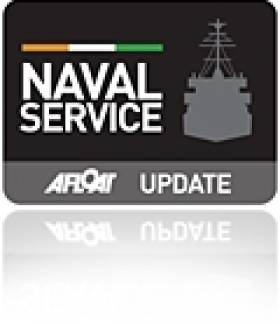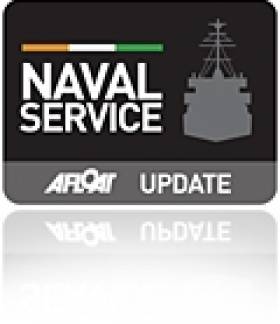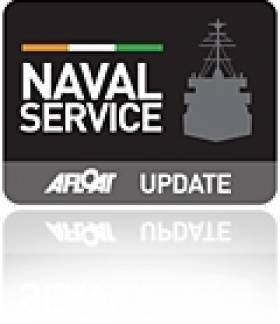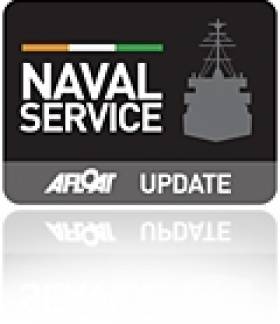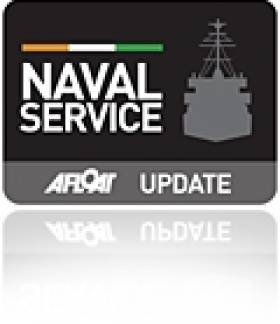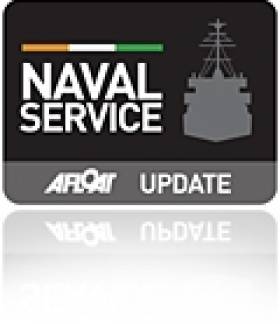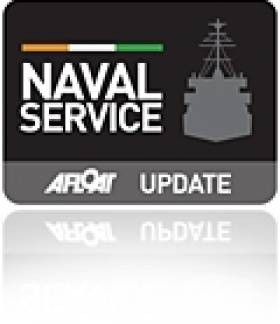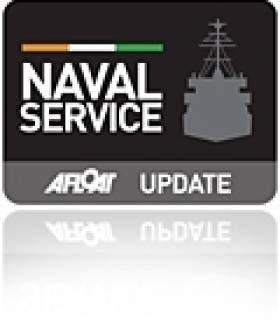Displaying items by tag: Navy
Naval Service Detain Foreign Fishing Vessels off South & West Coasts
#TrawlerDetentions – Two foreign fishing vessels were detained on Saturday by the Naval Service for alleged technical breach of fishing regulations.
The most recent detention took place in the evening when the Naval Service flagship L.É. Eithne (P31) detained a French registered fishing vessel approximately 120 nautical miles off the west Clare coast. The vessel was to be escorted by L.É. Eithne to Castletownbere, from where the vessel was expected to be handed over to An Gardaí Síochána.
Earlier that same day, L.É. Ashling (P23) detained a Spanish registered fishing vessel approximately 80 nautical miles south of Baltimore Bay. Likewise the Naval Service OPV escorted the detained vessel to Castletownbere and handed over to the Gardai.
These detentions bring to 10 the total number of fishing vessels so far detained by the Naval Service this year.
Naval Service Fleet 'Stuck In Dry-Docks'
#NavalMaintanance – Almost half the Naval Service fleet was simultaneously out of action due to maintenance problems, a military conference has been told.
According to the Irish Independent which has more on this story, the troops attending the conference heard that three out of the eight vessels were in dry dock together for "unscheduled" repairs.
The plight of the Naval Service was revealed last night by Gerry Rooney, general secretary of PDFORRA, the representative association for soldiers, sailors and aircrew.
Naval Service 'Flagship' Detains French Fishing Trawler
#TrawlerDetained- Naval Service 'flagship' L.É. Eithne (P31)detained a French registered fishing trawler yesterday, approximately 150 nautical miles south off Mizen Head on the Cork coastline.
The detention was in relation to an alleged technical breach of fishing regulations. The vessel was to be escorted and arrive alongside Cobh this morning and handed over to An Gardaí Síochána.
This brings to a total of 804 vessels boarded in 2013 by the Naval Service. There have been 24 warnings issued and this is the 8th vessel detained so far this year.
Now that the L.E. Emer is decommissioned, the former OPV carried out more than 6,000 trawler boardings during her 35 year career. The former naval ship is moored at the Naval Base, Haulbowline. She is to be put up for sale (unless previously sold) later this month.
The naval fleet is reduced to a total of seven patrol vessels. 'Emer's direct replacement, the newbuild PV90 class L.É Samuel Beckett (P61) is expected to be floated-out next month and delivered in February 2015.
Naval Service Newbuild OPV to be Floated-Out in November
#NavalNEWBUILDS – L.E. Samuel Beckett, the first of a pair of newbuild OPV vessels under construction for the Naval Service was expected to be floated-out next month, however this has been re-scheduled to November, writes Jehan Ashmore.
As previously reported last Friday's edition of 'Seascapes' exclusively featured a recorded interview of Commodore Mark Mellett, Flag Officer Commanding of the Naval Service, who spoke of the floating-out of the first new offshore patrol vessel.
According to the Naval Service, it now transpires that the OPV to be named L.E. Samuel Beckett will instead be floated-out in November, though this remains subject to a variety of circumstances among them the state of the tide.
The north Devon shipyard near Bideford is located at Appledore on the muddy banks of the river Torridge which is close to the confluence of the Taw river. Together they form an estuary that flows into the Bristol Channel with up to a 9m tidal range.
L.E. Samuel Beckett is scheduled to be delivered in early 2014 and the second newbuild OPV, L.E. James Joyce is to be delivered a year apart in early 2015. The order for the pair of PV90 class vessels are worth €99m and the work is contracted to Babcock Marine.
The same shipyard, albeit under different ownership had built the PV80 class or 'Roisin' pair which are a design derivitive for the newbuilds currently undergoing construction. Primarily the PV90 class will have an extended hull of 10 metres totalling 90 metres so to improve sea-keeping characteristics particularly in the Atlantic.
Notably the PV90's are to feature drones or "unmanned aerial surveillance vehicles" and robotic submersibles.
It is understood that the afterdeck will have additional space compared to L.E. Roisin (P51) and L.E. Niamh (P52) in that modular units (i.e containers) can be stowed for purposes of overseas missions.
As previously reported, the newbuilds will make a break from tradition in the choice of vessel names are taken from Irish 'male' Nobel-prize winning writers rather than 'female' names based from Celtic mythical figures.
L.E. Emer’s Public Auction to Take Place in Carrigaline, Co. Cork
#AuctionEMER - Cork Auctioneer Dominic Daly is to handle the sale of the decommissioned Naval Service OPV L.E. Emer (P21) which is to be put up for public auction in a month's time, writes Jehan Ashmore.
The auctioneer is to host the public auction in the Carrigaline Court Hotel, Carrigaline on the southern outskirts of Cork City at 12 noon on Wednesday 23 October. The vessel unless previously sold is on view as seen in Cork Harbour. See advert here.
L.E. Emer was the second of four coastal patrol vessels (CPV). They were later re-classified as offshore patrol vessels (OPV). The original leadship, L.E. Deirdre (P20) was decommissioned in 2001 and sold for €190,000. She was converted into a luxury yacht.
In disposing the 35 year old OPV, potentially interested parties could come from a variety of sources and for the following purposes including the conversion for the super-yacht market or as use as an offshore energy supply or a research vessel.
According to the auctioneer's website, a sister of L.E. Emer, the L.E. Aoife (P22) will also go on the market in 12 months time. The two Irish-built vessels were launched at Verolme Cork Dockyard in 1978 and 1980 respectively.
L.E. Emer's keel was laid in March 1977 and six month later she was launched. Her hand-over to the Naval Service took place in January 1978.
Workers spent 26 weeks on the vessel while on the slipway stocks and a further 15 weeks were carried out involving outfitting. Combined, the construction period totalled 280,077 hours and the they say the rest is history in a career that saw her clock up approximately 518,000 miles.
L.E. Emer and L.E. Aoife are to be replaced by a pair of OPV newbuilds currently under construction in a north Devon shipyard.
As previously reported, the PV90 design or enhanced 'Roisin' class are to cost €49m each in a contract that was awarded to Babcock Marine with the first steel cut in May last year which led to the first newbuild L.E. Samuel Beckett which is due to be floated-out next month.
It is understood she is to be delivered next year and followed by second vessel, L.E. James Joyce with a delivery in 2015.
Ex-Officers Group Say Naval Service Should Take Part in UN and EU Missions
#NavalServiceRole – Patrol vessels of the Irish Naval Service should participate in UN- and EU-sponsored "international maritime security" missions, according to the Irish Maritime Forum.
The State's fleet should also be expanded to match the size of New Zealand's navy, given that Ireland's maritime zone has expanded from 410,000sq km to 1 million sq km – more than 12 times the island's land area, the forum says in a submission to Government.
The forum, comprising former naval officers and mariners, says the Government's defence White Paper should redress the imbalance between the Army and Naval Service to reflect the fact that 92 per cent of Ireland is "under water" with "several trillion euro" in natural resource assets, ranging from hydocarbons to fish to wind and wave energy.
Commenting on the recently-published Green Paper on defence, the forum says it is "depressingly clear" that "land-centred thinking is dominant" in its drafting.
The forum says the Naval Service area of operations has "grown exponentially" since the publication of the Government's last White Paper on defence in 2000.
For much more on this story, today's Irish Times has a report.
L.E. Emer Heads Upriver of the Lee for Decommissioning Ceremony
#FarewellEMER – As previously reported, L.E. Emer (P21) of the Irish Naval Service which spent a career spanning more than 35 years, was decommissioned at a ceremony held in Cork City Quays today, writes Jehan Ashmore.
The oldest vessel in the service, the 1978 built LE Emer was the first of a trio launched from Verolme Cork Dockyard (V.C.D) from where she was commissioned on 16 January of that same year.
Notable highlights of her career include the following:
• First Naval Service vessel to carry out UNIFIL re-supply mission in 1979 to South Lebanon.
• Participated in the search and rescue (SAR) operation during the Fastnet Race disaster off the West Cork coast in 1979.
• She played a key role in the seizure of the gun-running fishing vessel "Marita Anne" in 1984.
The 'Emer' CPV class vessel (later reclassified in recent years as an OPV) was designed as an improved version of the CPV L.E. Deirdre(P20).
L.E. Deirdre played a significant historic milestone in that she represented the state's first custom-built naval vessel and which too was launched in 1972 by V.C.D. at the Rushbrooke shipyard near Cobh. She was decommissioned in 2001 and sold for €190,000 and converted into a luxury yacht.
On her final return to Cork Harbour yesterday, L.E. Emer had completed on what would be her last patrol when she berthed along the quay at the foot the Naval Service Base control tower on Haulbowline Island.
L.E. Emer was under the command of captain Lieutenant Commander Alan O'Regan, a Cork native who became the last of 23 captains that have taken charge of the vessel spanning more than three decades.
This afternoon L.E. Emer made the short passage from Haulbowline to Cork City at Customs House Quay North, which en-route involved the 1,019.5 displacement tonnes vessel navigating through Lough Mahon.
Next month she will be put up for sale at a public auction.
Tonight's edition of 'Seacapes' has an interview with Commodore Mark Mellett, Flag Officer Commanding of the Naval Service which includes reviewing the overall fleet. Alternatively you can hear the interview now as a podcast version in advance of the programme to be broadcast on RTÉ Radio 1 starting at 22.30hrs.
LE Emer to Decommission After 36 Years Naval Service
#FarewellEMER – Irish Naval Service vessel LE Emer (P21) is being decommissioned from the service today after almost 36 years in use.
The oldest vessel in the service, LE Emer was built in Verolme Cork Dockyard and was commissioned on January 16th, 1978. The vessel has had 23 captains and the service estimated it has sailed 518,000 nautical miles during its career.
The final serving captain is Lt Cmdr Alan O'Regan, a Cork native. For more on this story,The Irish Times reports.
Afloat.ie adds that the L.E. Emer completed her last stretch of her final patrol duties that saw her depart Dublin Port on Monday of this week. The OPV is currently moored alongside the outer quay of the Naval Service Base on Haulbowline Island.
As previously reported, an interview with Commodore Mark Mellett, Flag Officer Commanding of the Naval Service. To hear the interview click this link to the podcast version in advance of tonight's RTE Radio 1's 'Seascapes' programme starting at 22.30hrs.
A Flying Send-Off as L.E. Emer Bids Dublin Bay Farewell
#FarewellEMER - Today the sell-listed L.E. Emer (P21) departed Dublin Port for the final time and it was also the Naval Service OPV's last patrol, writes Jehan Ashmore.
She headed out of Dublin Bay under the command of Lt .Cdr. Alan O'Regan and where she set a southerly course to pass the Muglins off Dalkey Island.
At the same time of her late morning exodus of the bay, a former World War II serving Catalina flying-boat soared above. The distinctive aircraft was heading eastwards over the Irish Sea, having taken part in yesterday's Flight Fest hosted in the capital.
L.E.Emer is scheduled to complete her patrol duties next Friday at the Naval Base in Haulbowline, Cork Harbour.
She will be decommissioned and next month put up for public auction unless previously sold. A pair of replacement OPV newbuilds are under contruction in the UK with the first of the improved 'Roisin' class due for delivery next year.
Flight Fest Flyover Above Dublin Port Sees Return of ‘Farewell’ L.E. Emer
#FarewellEMER – This Sunday's spectacular Flight Fest Flyover above Dublin Port and city-centre quays is from where the event is to be officially launched by the LE. Emer (P21), writes Jehan Ashmore.
The return to Dublin Port of the sell-listed Naval Service offshore patrol vessel follows a recent call to the capital only last week. On that occasion she made a special farewell cruise in Dublin Bay for former sailors.
So it transpires that this visit to Dublin Port is in fact likely to be her 'final' call to the capital while also performing her last patrol duties.
The 1978 built veteran is to decommission on 20 September and if not previously sold the 65.5m long vessel is to go for public auction next month.


























